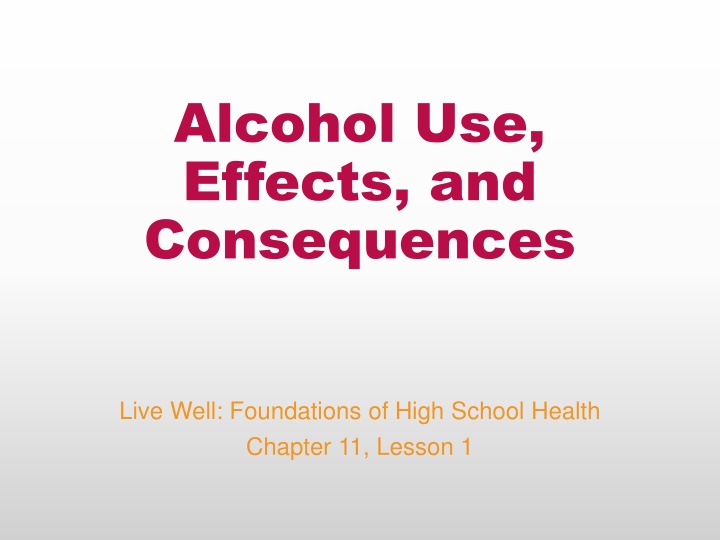
Understanding Alcohol: Types, Effects, and Consequences
Explore the world of alcohol, including its various types, effects on health, standard drink sizes, impacts on behavior and performance, and risks associated with alcohol consumption. Learn about the emotional reasons for alcohol use and ways to reduce teen alcohol consumption for a healthier lifestyle.
Download Presentation

Please find below an Image/Link to download the presentation.
The content on the website is provided AS IS for your information and personal use only. It may not be sold, licensed, or shared on other websites without obtaining consent from the author. If you encounter any issues during the download, it is possible that the publisher has removed the file from their server.
You are allowed to download the files provided on this website for personal or commercial use, subject to the condition that they are used lawfully. All files are the property of their respective owners.
The content on the website is provided AS IS for your information and personal use only. It may not be sold, licensed, or shared on other websites without obtaining consent from the author.
E N D
Presentation Transcript
Alcohol Use, Effects, and Consequences Live Well: Foundations of High School Health Chapter 11, Lesson 1
Write About It What do you know about the different types of alcoholic drinks? Do they all contain the same amount of alcohol? Is there a standard drink size?
Can you . . . Describe standard drink sizes of alcoholic beverages? Analyze specific components of the fetal alcohol spectrum disorders? Illustrate how teen alcohol use has an impact on risk-taking behaviors? Compare how alcohol consumption can affect school and job performance? Examine the potential impacts drinking and driving has on a person s life?
What Is Alcohol? Alcohol is one of the most used and abused substances for high school students. Alcohol is legal only for people 21 and older. Alcohol is a depressant. Makes brain function slower than normal Makes basic tasks, like walking, talking, and making simple decisions, more difficult The most common types of alcohol are beer, wine, and liquor.
Standard Sizes of Alcoholic Drinks
Alcohol Consumption Moderate drinking, or social drinking, means having up to one drink per day for women and up to two drinks per day for men. Binge drinking means consuming many drinks in a short amount of time and on a regular basis. Heavy drinking for a male is more than four drinks a day or 15 or more per week. Heavy drinking for a female is more than three drinks a day or eight or more per week.
Teen Alcohol Use and Risk Taking Teens who have been drinking alcohol are more likely to take risks than those who have not. The risks may result in falls, drownings, burns, and unintentional firearm injuries. Drinking also causes teens to become more violent and more liable to get into fights.
Emotional Reasons for Alcohol Use Increase positive mood Gain approval Reduce painful, negative feelings Fit in
Reducing Teen Alcohol Consumption Teens drink to increase their positive mood, to gain approval or fit in with peers, or to reduce the pain of negative feelings. There is no easy way to prevent teens from using alcohol. Teens should be taught that there are other ways than drinking to celebrate something or work through something.
Factors That Influence the Effects of Alcohol Body size The larger a person is, the more drinks it will take to become intoxicated. How fast the alcohol is consumed The faster a person drinks alcohol, the faster they will become intoxicated. How much a person drinks The more a person drinks, the higher the level of alcohol in their bloodstream.
Physical Effects of Alcohol Short-term effects Blurred or double vision Increased sweating and flushed skin Dehydration Nausea, vomiting, and indigestion Long-term effects Risk of brain damage, memory loss, and stroke Cardiovascular disease and high blood pressure Cirrhosis of the liver (irreversible scarring) Inflamed and bleeding stomach lining
Effects of Alcohol During Pregnancy If a woman drinks alcohol when she is pregnant, her fetus also absorbs the alcohol. Drinking alcohol during pregnancy can cause miscarriages, stillbirths, and fetal alcohol spectrum disorder (FASD). FASD is a group of conditions that can cause a child to have physical, behavior, and learning problems.
Consequences of Alcohol Use Mental consequences include reduced ability to do simple tasks and impaired brain development. Social consequences include lost friends, damaged relations with family, and poor school performance. Legal consequences include a possible charge as a minor in possession (MIP), a misdemeanor punishable by up to one year in jail.
Drinking and Driving There is zero tolerance for anyone under 21 drinking and driving. Teenage drivers convicted of driving under the influence (DUI) or driving while intoxicated (DWI) can have their driving licenses suspended or permanently revoked. Car crashes are the leading cause of death for teens. About a quarter of these crashes involve underage drinking.
Blood Alcohol Content Blood alcohol content (BAC) is the amount of alcohol in the bloodstream. BAC indicates how intoxicated a person is. Intoxicated means alcohol is affecting the person s ability to do simple tasks like walking and talking. In the United States, a person is considered legally impaired or intoxicated if they have a BAC of 0.08 percent or higher.
Skill-Building Challenge Use the Internet to research the national SADD organization. Using information from the SADD website, explain how you would advocate for having a SADD chapter at your school. Explain why a SADD chapter is needed and what message you will use to promote the chapter.
